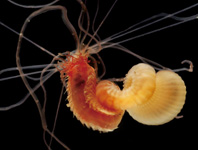Abstract
The genera Nyphaeba Pascoe and Pantiala Pascoe of Cryptorhynchinae are redescribed and revised. Lectotypes are designated for the names Nyphaeba monommoides Pascoe and Pantiala illusa Pascoe. This facilitates the description of Nyphaeba mimica sp. n. represented by two paralectotypes of Pantiala illusa. Both genera are excluded from the subtribe Tylodina Lacordaire based on their possession of wings and a distinct metanepisternum. The following new combination for a species originally described in Pantiala is proposed: Nyphaeba germari (Faust). A femora-abdominal stridulatory mechanism is observed for Nyphaeba. This case illustrates how nomenclatural problems evident from type material can persist in an understudied taxon for more than a century. Such problems severely affect modern research and databasing.
References
Alonso-Zarazaga, M.A. & Lyal, C.H.C. (1999) A world catalogue of families and genera of Curculionoidea (Insecta: Coleoptera) (excepting Scolytidae and Platypodidae). Entomopraxis, Barcelona, 315 pp.
Fontaine, B., Perrard, A. & Bouchet, P. (2012) 21 years of shelf life between discovery and description of new species. Current Biology, 22 (22), 943–944. [R943–R944]
http://dx.doi.org/10.1016/j.cub.2012.10.029Gaiger, F. & Vanin, S.A. (2006) The elytro-femoral stridulatory apparatus in Curculionidae (Coleoptera), with notes on the acoustic behaviour of Arniticus hylobioides (Boheman 1843) and Erodiscus proximus (Viana 1959), and thanatosis display in the latter species. Annales de la Société entomologique de France, 42 (2), 165–170.
https://doi.org/10.1080/00379271.2006.10700619Hustache, A. (1934) Curculionidae: Zygopinae. In: Schenkling, S. (Ed.), Coleopterorum Catalogus auspiciis et auxilio W. Junk, 136, 1–96.
Beutel, R.G. & Leschen, R.A.B. (2005) Handbook of Zoology. Vol. IV. Part 38. Coleoptera, Beetles. Vol. 1. Morphology and Systematics (Archostemata, Adephaga, Myxophaga, Polyphaga partim). Walter de Gruyter, Berlin, 567 pp.
Faust, J. (1898) Curculioniden aus dem Malayischen und Polynesischen Inselgebiet. II. Stettiner Entomologische Zeitung, 59 (1–6), 140–213.
Leschen R.A.B., Beutel, R.G., Lawrence, J.F. & Slipinski, A. (2009) Handbook of Zoology, Vol. IV. Part 38. Coleoptera, Beetles. Vol. 2. Morphology and Systematics (Elateroidea, Bostrichiformia, Cucujiformia partim). Walter de Gruyter, Berlin, 786 pp.
Lyal, C.H.C. (1993) Coleoptera: Cryptorhynchinae. In: Fauna of New Zealand. Vol. 29. Canterbury, Lincoln, 308 pp.
Lyal, C.H.C. (2014) 3.7.7 Molytinae Schoenherr, 1823. In: Leschen, R.A.B. & Beutel, R.G. (Eds.), Handbook of Zoology, Coleoptera, Beetles. Vol. 3. Morphology and Systematics (Phytophaga). DeGruyter, Berlin, pp. 529–570.
Lyal, C.H.C. & King, T. (1996) Elytro-tergal stridulation in weevils (Insecta: Coleoptera; Curculionoidea). Journal of Natural History, 30, 703–773.
https://doi.org/10.1080/00222939600770391Lyal, C.H.C., Douglas, D.A. & Hine, S.J. (2006) Morphology and systematic significance of sclerolepidia in the weevils (Coleoptera: Curculionoidea). Systematics and Biodiversity, 4, 203–241.
https://doi.org/10.1017/S1477200005001714Pascoe, F.P. (1871a) Catalogue of Zygopinae, a subfamily of Curculionidae, found by Mr Wallace in the Eastern Archipelago. Annals and Magazine of Natural History, Series 4, 7 (39), 198–222.
Pascoe, F.P. (1871b) Catalogue of Zygopinae, a subfamily of Curculionidae, found by Mr Wallace in the Eastern Archipelago. Annals and Magazine of Natural History, Series 4, 7 (40), 258–266, pls. XV–XVI.
Pascoe, F.P. (1885) List of the Curculionidae of the Malay Archipelago collected by Dr. Odoardo Beccari, L. M. D'Albertis, and others. Annali del Museo Civico di Storia Naturale di Genova, 22, 201–332, pls. I–III.
Riedel, A. (2005) Digital imaging of beetles (Coleoptera) and other three-dimensional insects. In: Häuser, C., Steiner, A., Holstein, J. & Scoble, M.J. (Eds.), Digital Imaging of Biological Type Specimens. A Manual of Best Practice. Results from a study of the European Network for Biodiversity Information. Staatliches Museum für Naturkunde, Stuttgart, pp. 222–250.
Riedel, A., Daawia, D. & Balke, M. (2010) Deep cox1 divergence and hyperdiversity of Trigonopterus weevils in a New Guinea mountain range (Coleoptera, Curculionidae). Zoologica Scripta, 39 (1), 63–74.
https://doi.org/10.1111/j.1463-6409.2009.00404.xRiedel, A., Sagata, K., Suhardjono, Y.R., Tänzler, R. & Balke, M. (2013) Integrative taxonomy on the fast track - towards more sustainability in biodiversity research. Frontiers in Zoology, 10, 15.
https://doi.org/10.1186/1742-9994-10-15Riedel, A., Tänzler, R., Pons, J., Suhardjono, Y.R. & Balke, M. (2016) Large-scale molecular phylogeny of Cryptorhynchinae (Coleoptera, Curculionidae) from multiple genes suggests American origin and later Australian radiation. Systematic Entomology, 41 (2), 492–503.
https://doi.org/10.1111/syen.12170Salam Rita Devi, Ray, D.C. & Ramamurthy, V.V. (2016) Descriptions of three new species of Strattis Pascoe, 1883 (Coleoptera: Curculionidae: Cryptorhynchinae) from the Indian subcontinent. Zootaxa, 4085 (2), 199–218.
https://doi.org/10.11646/zootaxa.4085.2.2Setliff, G.P. (2012) Revision of Asytesta Pascoe, 1865, with comments on the phylogeny of the Indo-Australian crowned weevils (Coleoptera: Curculionidae: Cryptorhynchinae). Zootaxa, 3462 (2), 1–125.
https://doi.org/10.11646/zootaxa.4085.2.2Tänzler, R., Sagata, K., Surbakti, S., Balke, M. & Riedel, A. (2012) DNA barcoding for community ecology - how to tackle a hyperdiverse, mostly undescribed Melanesian fauna. PLoS ONE, 7 (1), e28832.
https://doi.org/10.1371/journal.pone.0028832

